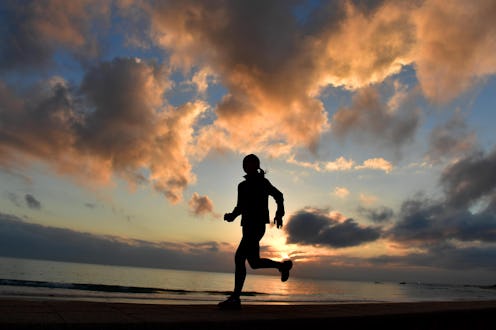Life
Feeling Extra Sore After A Workout Could Be A Sign Of This Health Issue

If you’ve ever innocently gone too hard during your spin class, only to wince in pain with extreme soreness the next morning, you’ve experienced post-workout delayed onset muscle soreness, or DOMS. This basically means that, in the process of working to strengthen your muscles, the fibers have broken down to the point where the muscle repair process feels painful.
"DOMS is a normal response when you break out of your comfort zone," Aaptiv trainer Ackeem Emmons tells Bustle via email. "Our bodies are used to a certain amount of stress and load. When we train past that point, DOMS should be expected."
DOMS typically sets in within 24 to 72 hours post-workout, and, while usually nothing to be too worried about, it can be surprisingly painful. If you felt like a million bucks after your workout the day before, it can feel frustrating to be in so much pain the next day that just getting out of bed feels like a major accomplishment. But how do you know if your DOMS is benign, or the result of something more serious?
Strength-building workouts cause tiny, microscopic tears in the muscles and adjacent connective tissues, according to LiveScience, so some soreness after strength training is typical. DOMS doesn’t happen with every workout, either — it's more common if you’ve introduced some new movement to your routine, or worked your body in a different way than usual.
LiveScience notes that, contrary to what you’ve probably heard about post-workout muscle soreness, DOMS is actually not the result of lactic acid buildup in the body — it’s caused by the muscle repair process. Sometimes, DOMS can also mean that you’ve sustained more significant damage to your muscles, so it’s always helpful to make sure you’re challenging your body during workouts, while not pushing too hard.
Well + Good reports that DOMS typically affects people who are new to working out. If you’ve taken a couple of weeks off, you might also feel extra sore when you get back to hitting the gym. “It can totally throw you for a loop,” Adam Rosante, trainer, nutrition coach, and founder of The People’s Bootcamp told Well + Good. “But don’t panic: DOMS is normal. Know that your body is repairing so that it can handle a greater workload moving forward.”
And while it might seem counterintuitive, exercising *very lightly*, in addition to gently stretching your muscles as you’re able to, might actually help lessen that soreness more quickly, too, LiveScience says. According to VeryWell Fit, you might need a rest day or two if your muscles are really sore. If you're able to, light yoga, light-to-moderate cardio exercise, or gentle weight training might help with DOMS. Make sure to listen to your body, and rest if you need to rest, though. Emmons also recommends foam rolling for DOMS relief.
"You will know if DOMS is pointing to something more serious if you still feel residual pain after three to five days," Emmons says. If your post-exercise pain is feeling super intense or debilitating, and it’s not lessening within a 72 to 96 hour window of time, then there could be cause for concern, says CNN. If you’re also experiencing any swelling in your limbs, or your pee suddenly gets really dark, go see your doctor as soon as you can. According to Popular Science, rhabdomyolysis, or rhabdo, is a potentially life threatening condition in which waste from muscle fibers breaking down floods the bloodstream, and overwhelms the kidneys as a result. Rhabdo can happen as a result of *very* extreme exercise, but it’s also a treatable condition and pretty rare.
So while your post-HIIT class soreness is probably not anything to worry about, it’s always important to listen to your body when you work out. "Although DOMS can be uncomfortable and raise concern, it's also a great way to gauge the intensity of your training program," Emmons says.
If you feel sudden or sharp pain during exercise, or if something feels painful or off, stop your workout, and see your doctor if you think you might be injured. You may also need medical attention if your DOMS is debilitating, and accompanied by other symptoms like swelling. In typical cases of DOMS, however, symptoms should improve within a few days.